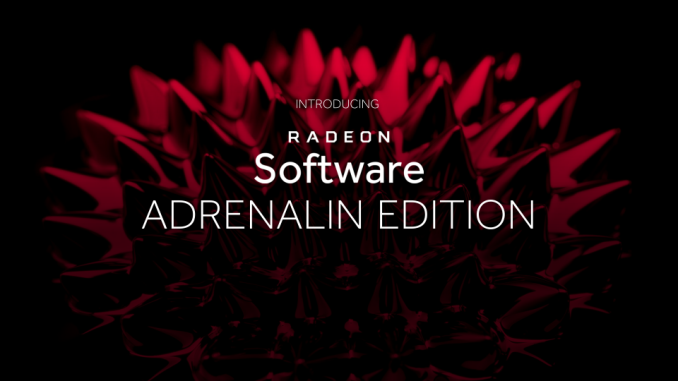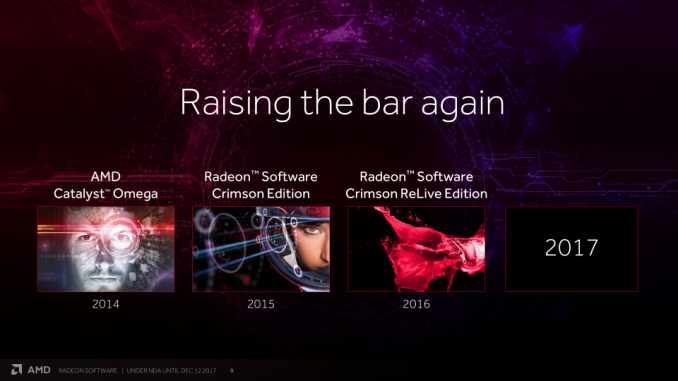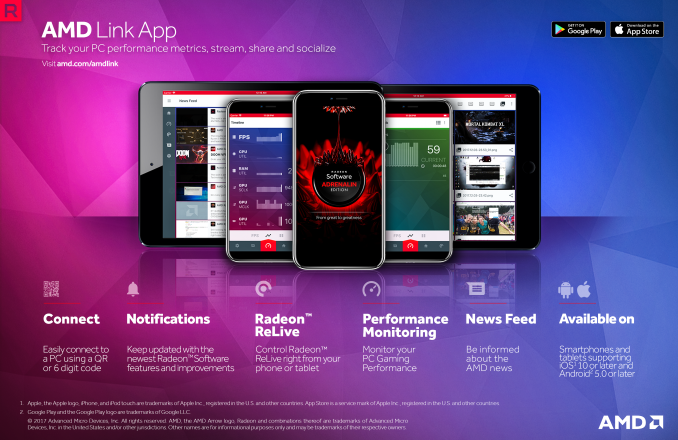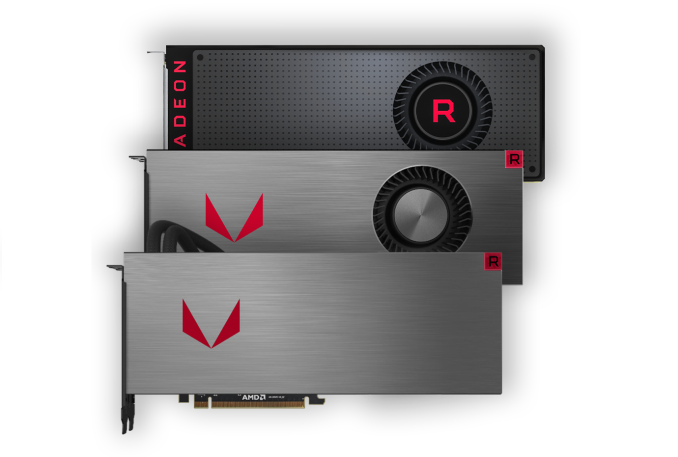AMD Releases Radeon Software Adrenalin Edition: Overlay, App & More for 2017
by Nate Oh on December 12, 2017 9:00 AM EST
A few weeks ago, AMD took the courtesy of revealing the name (and nothing else) of their upcoming 2017 major feature update for Radeon Software. But today, the totality of AMD’s Radeon Software Adrenalin Edition is finally upon us. Succeeding Crimson and Crimson ReLive Editions, Adrenalin continues AMD’s yearly cadence of driver software features pushing, among other things, the user experience (UX) angle.
For the headliners, Adrenalin introduces the new Radeon Overlay and the AMD Link mobile app. Beyond that, this update is quite reminiscent of Radeon Software Crimson ReLive 17.7.2, bringing a number of widespread improvements and expanded support for current features. Among the highlights is Enhanced Sync 'E-Sync' for all GCN GPUs, a generic Radeon Chill profile, WattMan profile saving/loading, a slew of new ReLive streamer features, and streamer-oriented social media integration. Otherwise, Adrenalin 17.12.1 comes with a bevy of bug fixes for games, including, yes, a fix for the Overwatch hanging issue.
Radeon Software in 2017: What’s Old is New and What’s New is New
To start, Adrenalin is in a curious spot considering that July’s wide-ranging 17.7.2 already brought a variety of enhancements and features. So as a yearly feature update, there’s less build-up than Crimson or Crimson ReLive. And in some ways, Adrenalin is less flashy than Crimson ReLive, which included so many hardware-dependent features that tables were necessary to make sense of it all.
While this might make Adrenalin seem less extensive, today’s release is simply more UX and streaming/social focused, building off of what has already been established in previous versions. For Adrenalin’s marquee features, Radeon Overlay and AMD Link, they are more about the different ways of presenting Radeon Settings features to the user, rather than features in and of itself.
As a set, AMD is pushing Enhanced Sync, ReLive, Radeon Chill, and WattMan together, and to a lesser extent Frame Rate Target Control (FRTC), most of which get wrapped up into Radeon Overlay (and AMD Link). We won’t be going too much in depth with the details of these technologies, but our earlier Crimson Edition and Crimson ReLive Edition coverage are worth reading if these terms are unfamiliar.
As for AMD’s promise of a minimum six annual WHQL drivers, they remain faithful. Adrenalin Edition 17.12.1 is intended to be WHQL certified at launch, and would mark the 8th WHQL release of the year (after 17.7.2, 17.9.3, and 17.11.1). Though to be clear, not all of these releases were WHQL certified at launch-day, but were updated later with WHQL certification. However, as we have mentioned in the past, WHQL certification does not cover game-specific bugs. So 17.11.1 WHQL has no bearing on whether Overwatch crashes or not (though Adrenalin does happen to resolve that particular issue).
But What About Vega?
A good amount of readers, and not just ours, are strongly under the impression that Adrenalin is an RX Vega super driver. This is not the case. Adrenalin is explicitly focused on the broader Radeon user base; it does not bring any Vega-specific performance enhancements or documented changes to the behavior of Vega-specific hardware features. As for game-dependent enhancements to pre-existing games – features like Wolfenstein II’s Rapid Packed Math (RPM) support and to a lesser extent GPU Culling and Deferred Rendering – Adrenalin is not bringing any of those either. On that note, AMD commented that “any functionality or enhancements would have been made available with our day-0 game drivers and not held back for Adrenalin Edition.” This follows AMD's previous committment to immediate day-0 driver updates over larger update packages for performance.
Given the nature of Vega’s forward-looking hardware features, this might be seen as surprising. But since Omega, these major annual updates were never intended to be all-in-one wonder drivers. And as AMD has reiterated over the past couple years, their driver release methodology has shifted to immediate release for bug-fixes and launch-day drivers, while major annual releases focused on quality assurance, user experience, and software feature updates. Even at the time of last year’s Crimson ReLive, AMD stated that the days of 40%+ performance increase drivers were set to disappear.
So in short, Adrenalin details nothing Vega-specific and there was no information disclosed on what Vega optimizations are coming when. The focus is on interaction and availability of the features within.














42 Comments
View All Comments
lmcd - Tuesday, December 12, 2017 - link
Didn't realize how far AMD has gotten. Would've considered purchasing except for the unfortunate power draw.While multiple people are claiming that power draw should not be a consideration for me within the United States, heat is a consideration as to both the product's lifespan and its case compatibility. As someone happy with my Silverstone SG09 (except, maybe, that it's not an SG10), an ITX form factor GTX 1070 was the obvious choice. The Vega 56 does not have any ITX models, to my knowledge, and any such options would require liquid cooling and a custom PCB (well out of my price range).
B3an - Tuesday, December 12, 2017 - link
Wish Nvidia had those streaming features but i'm not downgrading to a less powerful GPU for them.FourEyedGeek - Thursday, December 14, 2017 - link
The bait was thrown out, 3 days later no one has still bitten.PeachNCream - Tuesday, December 12, 2017 - link
I'm not so sure about the names of these driver releases from AMD. We've had ReLive and Adrenalin so is Amygdala or Pituitary next and when will we start exploring other hormones and neurotransmitters?extide - Tuesday, December 12, 2017 - link
It's Adrenalin, not Adrenaline. Adrenalin is a flower.rocky12345 - Tuesday, December 12, 2017 - link
Nice write up on this thank youI kinda like the new look of the overlay and actually getting better support for a lot of the settings we need. The smartphone connect thing is also nice but myself and maybe a lot of other people already use the onscreen performance monitors provided through MSI Afterburner+Riva Tuner together. I also hope they do not break my Sapphire 390x tri-x card again like when the first Crimson driver release happened it took about a year to get that sorted out. Then again since most of this is just feature updates and not driver related us 290 & 390 series owners should be fine.
Good to see AMD actually adding features a lot of people want it is to bad there are no Vega updates mind you I am sure the Vega owners were looking forward to some AMD love on the Vega front.
deksman2 - Tuesday, December 12, 2017 - link
People... the reason Vega's power draw is a bit higher in relation to Nvidia is because AMD is forced to use a 14nm process designed for low power and low clocks - plus, it usually overvolts its GPU's for the sake of improving yields, and both Vega 56 and 64 have much higher amount of stream processors, which means they have higher compute capabilites - and guess what, that takes power.Obviously if you go past a certain limit in clocks, power draw skyrockets.
The new 12nm process Vega refresh will be made should get rid of that problem and allow Vega to clock much higher with lower power draw.
On the other hand, if you also undervolt Vega on stock clocks and even overclock it, you can get Vega 56 to behave like Vega 64 performance wise, while drawing LESS power than 1080.
On the other hand in games that are optimised for PC platforms, also ones using DX12 and Vulkan, Vega 56 and 64 generally beat their Nvidia counterparts at stock.
Vega 56 at 2k and 4k for example is equivalent to 1080, while 64 gets within 10% of 1080ti.
Undervolt them both, and you gain better efficiency (more so on Vega 56 than 64).
But, as I said, the 12nm LP should allow Vega to clock on both the core and HBM to higher levels while using less power, and ergo will perform a lot better.
The 12nm LP is a process which Nvidia will be using for transitioning from current 16nm process (designed for high clocks).
Plus, before he left AMD, Raja Koduri mentioned that Vega's Infinity Fabric was not optimised for games and that game optimised versions of Vega are coming (most likely on 12nm LP).
Gigaplex - Tuesday, December 12, 2017 - link
Why is AMD forced to use a lesser manufacturing process? Neither AMD nor NVIDIA own fabs, they both subcontract to the same fab companies.JasonMZW20 - Tuesday, December 12, 2017 - link
The 14nm LPP process node is a decent process and is efficient. If it wasn't, Ryzen would've been a disaster. Sure, it's not the best out there, but it is a refined Samsung node that GloFo licensed. 12nm (14nm+) might be tech they acquired from IBM. "12nm" isn't a cure-all for Vega though; large dies have notoriously poor yields and 12nm won't shrink the die size (does have improved density though). Sure, it'll allow slightly higher clocks within the current 295W TBP (345W for LC) or they can offer the same clocks with a lower 236/170W (64/56) TBP (Flat 25% power reduction from 295/210W). True 2Gbps HBM2 would help too, as HBM2 voltage spec is 1.200v, but Vega64 has to use 1.356v to overclock HBM to 945MHz (from 800MHz).Vega uses more power simply because of what you said: amount of shader processors and higher stock voltages than optimal. Ryzen and Vega are similar in that they're pushed a little bit past their efficiency point. I've achieved good efficiency by undervolting, but I've completely given up on OC because my Vega64s just aren't compliant without significantly raising voltage and spiking power draw for a few percentage points of increased processing power (and maybe 5fps for an extra 40W). I need over 1.150v just to get 1677MHz. I stick to about 1565-1605MHz at 1.018-1.025v with good overall performance and reduced power usage.
Keep Vega below 65C and you'll reduce chip leakage as well. I reduced power usage by 10-15W just by doing that on my air cooled cards (tested both with the same settings aside from temp target and 75C card consistently used 10-15W more with spikes up to 25W at times). 10-15W can get you a bit more headroom for GPU turbo.
Also, Infinity Fabric auto overclocks with memory speed. At/After 1115MHz HBM, IF domain overclocks to 1200MHz (from 1107MHz), which can slightly improve overall performance if you can get it stable (HBCC, especially).
mapesdhs - Thursday, December 14, 2017 - link
#include <rant.h>When did drivers start being given marketing product names as if they were physical things? At this rate driver releases are going to get "reviews" just like any other product, and they won't be free anymore.